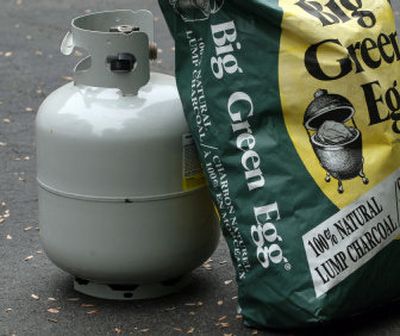Carbon copies?

Like many serious grillers, Pedro Verdugo loves the taste hardwood charcoal gives to food.
It’s not just the aroma, that savory smokiness that permeates the food. It’s also the searing heat the charcoal provides to lock in the natural flavors of steaks, chops and seafood.
But the Boston Web designer admits there is a lingering guilt linked to this love. Not because he is a carnivore, but because he uses charcoal instead of propane, which he suspects may be more environmentally friendly.
“It’s been in the back of my mind,” says Verdugo, 38. “How do I reduce my carbon footprint? One way would be to make the switch to propane.”
Whether propane or charcoal is more eco-friendly is no easy question.
Propane does win the popularity vote. While charcoal grill shipments dropped from 7.8 million to 6.8 million between 1985 and 2006, gas grills jumped from 3.1 million to 10.1 million, according to the Hearth, Patio and Barbecue Association.
“It’s easy. It’s quick to light,” the group’s spokesman, Don Johnson, says of propane’s appeal. “The charcoal people will insist the reason they use charcoal, even though it’s not as convenient, is for the taste.”
And among those who choose charcoal, briquettes are still the choice of most by far, though hardwood lump sales are rising.
Lump charcoal sales went from about 17,000 tons in 1993 to 100,000 tons in 2006, while briquette sales remained essentially flat, the Barbecue Association says.
But what’s best if you want what’s best for the environment?
Propane has about one-third the emissions per BTU (a unit for measuring heat output) compared with charcoal briquettes, according to a comparison by researchers at the Department of Energy’s Oak Ridge National Laboratories.
But because hardwood charcoals burn hotter than briquettes, their BTU-to-emissions ratio is better, the comparison found.
Also, burning a fossil fuel such as propane releases carbon that has been stored underground for millions of years. Charcoal is made from trees that take carbon dioxide from the atmosphere as they grow.
When the charcoal is burned the carbon dioxide is returned to the atmosphere, closing a carbon neutral cycle, charcoal supporters argue. The problem lies in whether the tree that is cut down to make the charcoal is replanted, prompting calls by some for the use of charcoal produced by sustainable methods.
“In terms of carbon emissions, strictly speaking, since wood is a renewable resource, that is the only one of these that is carbon neutral,” says Tristram West, who conducted the Oak Ridge analysis.
However, West says that in order for the use of charcoal to be considered carbon neutral, the wood used to produce the charcoal must come from sustainable forestry practices in which the trees cut down are regrown.
Trouble is, not all manufacturers include sustainability information on their packaging, making it difficult for consumers to know how it was produced.
Further muddying the situation, charcoal briquettes (small bits of charcoal held together with a binding material) often contain coal, a fossil fuel, and other additives to make them light quicker and burn better.
Dan Staublin, a spokesman for Kingsford Charcoal, notes the company’s products are made from wood scraps that otherwise would wind up in landfills. Kingsford produces briquettes and a hardwood lump charcoal it calls charwood.
Heat produced in making the charcoal – which is produced by controlled burning of the wood – also is used to run steam generators that produce electricity for the plants, which have state-of-the-art emissions controls, Staublin says.
And in Britain, the Royal Botanic Gardens in Kew produces its own Bar-B-Kew brand charcoal from wood grown under a forest-management practice known as coppicing, which involves the cutting of a tree back to a stump and using the shoots that spring from the trunk. Coppiced trees grow back quicker and live longer than if the tree had not been cut back and the use of charcoal made from coppiced woodlands supports sustainable production, advocates say.
The process does take time. Ash trees, for example, are typically coppiced on a 14 to 21 year cycle for charcoal production. Oak is every 25 to 35 years.
However, that sort of careful production isn’t universal, especially in developing countries, where charcoal often is a key source of energy and its production can lead to deforestation.
University of Maryland engineering professor Eugene Keating, an expert on combustion methods and fuels, says the answer isn’t as simple as picking one fuel over the other.
“You have to look at the whole mix,” he says. “If we go to one of these alternatives, the next thing we’ve done is very quickly outgrown our tree requirements. There just isn’t enough.”
The debate also should be kept in perspective, the Oak Ridge researchers noted in their comparison, adding that barbecue emissions are a tiny fraction of the carbon dioxide emitted annually in the United States.
Verdugo, meanwhile, says he is “not sure which way to go. For now, I’m sticking with the charcoal. I’m set up with it for one, and I like the way it tastes.”